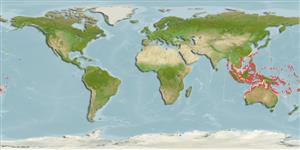Common names from other countries
Classification / Names / Names
Common names | Synonyms | Catalog of Fishes (gen., sp.) | ITIS | CoL | WoRMS
Environment: milieu / climate zone / depth range / distribution range
Ecology
Reef-associated; depth range 0 - 30 m (Ref. 348). Tropical; 23°C - 30°C (Ref. 102835); 29°N - 28°S, 91°E - 170°W
Indo-West Pacific.
Length at first maturity / Size / Weight / Age
Maturity: Lm ?, range 13 - 15 cm Max length : 50.0 cm SHL male/unsexed; (Ref. 117184); common length : 20.0 cm SHL male/unsexed; (Ref. 348)
The valves are thick, heavy and triangular in shape, often covered with reddish spots and obscured by encrustations. The mantle is a deep yellowgreen, irregularly mottled at the periphery and in the center.
Collected for food and shell, the latter commonly used in the shellcraft industry (Ref. 348). Maximum depth from Ref. 75831.
Life cycle and mating behavior
Maturity | Reproduction | Spawning | Eggs | Fecundity | Larvae
Broadcast spawners. Life cycle: Embryos develop into free-swimming trocophore larvae, succeeded by the bivalve veliger, resembling a miniature clam (Ref. 833).
Poutiers, J.M. 1998. (Ref. 348)
IUCN Red List Status (Ref. 130435: Version 2024-1)
CITES status (Ref. 108899)
Not Evaluated
Threat to humans
Harmless
Human uses
Fisheries: commercial; aquaculture: commercial
| FishSource | Sea Around Us
Tools
Internet sources
Estimates based on models
Preferred temperature
(Ref.
115969): 25.6 - 29.3, mean 28.7 (based on 2485 cells).
Resilience
Low, minimum population doubling time 4.5 - 14 years (K=0.12-0.2; tm=4).
Vulnerability
Moderate to high vulnerability (53 of 100).
Price category
Unknown.
